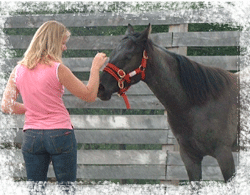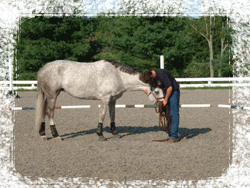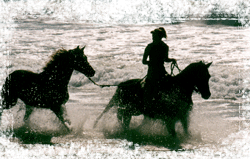I am very fortunate. When I look back over my life, for the most part, I have always wanted to get out of bed, welcome the day, and witness what life has in store for me. It’s the thought of those every day wonders about to happen right in front of my eyes that keep me excited; seeing the miracles nature has to offer, meeting the people and experiencing the multitude of cultures all around the globe.
I adore the fact that every experience is an opportunity to learn something new, albeit challenging at times. Each encounter with friends, family and those around me is a chance to gain and share insights into the life lessons individual to us all yet shared by everyone. And if we are paying attention we can witness the impact trickle down to the next person and the next and the next…
When working with your horse hold on to these types of feelings as best you can as this is what we want our horses to feel when they see us. We want them to greet us with joy and excitement asking, "What’s in store today?"
For those horses who don’t want to be close and run a mile when they see us approach we have a frustrating challenge on our hands. If we are to solve the problem of "catching a horse that doesn’t want to be caught", we have to ask the tough questions and be prepared for the answers no matter what they are. We have to ask what is the "real" reason they don’t want to be with us, what is the underlying cause?
Although the specific answers may be varied, in general that question can be answered in one sentence; they don’t see value in our presence. But what does this really mean to us? Our horses are trying to tell us something and it’s our responsibility to listen and understand. So it is time to stop trying to catch your horse and instead hear what your horse is saying. If you can change what your horse doesn’t like then you will never have to catch your horse again. Instead he will greet you with excitement and curiosity.
Discomfort
Before you do anything at all, you need to consider your horse’s wellbeing. As a living, breathing member of the planet that wellbeing includes physical, mental and emotional needs. Your horse may be trying to tell you how he feels physically. He will have begun to change his behaviour under saddle, expressed his feelings while being tacked-up and finally, with no more options available to him, moved on to show you he no longer wants to come to you as this means he will be subjected to discomfort yet again. So to start off…
Create a checklist of possibilities:
Tack-fitting: Saddle, girth, bridle
Teeth floating: Sharp edges, wolf teeth, abscesses, etc.
Injuries, illnesses & pain: Seek vet advice & then consider a chiropractor, massage therapist, acupuncture, energy healing, etc.
Hooves/shoe fitting: consult a farrier
Rider inability/error: maybe some lessons are in order
Once we take care of any physical pain we can then look at the possible emotional trauma they may have faced in the past. Just like humans, the loss of young, grieving missed friendships, location moves, inappropriate management and handling, and myriad other experiences can easily create trauma in a horse. These memories stay with them for life and it’s our commitment that helps them through these troubling experiences.
Tip: Consult professional advice to help your horse through any type of trauma or discomfort
Your Body Language
Like most beings on the planet, including humans, the horse’s language is primarily non-verbal. They express themselves through body language using gestures, actions, energy and visualization. They analyze your movements upon approach, intuitively reading your agenda, inner thoughts, feelings, beliefs and limitations.
The way you carry yourself gives your horse a great deal of information about you and what is on your mind for the day. If there are time pressures, concerns or fears they will know. Some horses pride themselves on supporting their "guardian" during these situations, while others feel its best to just not get involved and walk the other way.
Tip: Leave your baggage at the gate and don’t let it interfere with your horse work.
Your horse’s body language
The horse’s language is predictable, discernable and effective. It’s a language that can be learned and although, in their eyes we are predators, we can bridge the gap between the two worlds.
Observe horses in their natural habitat and you will witness the intricacies of their communication and interactions. Even the subtlest of gestures speaks loudly to a horse. It’s important to remember that when you walk out to the pasture. Are you yelling at them with your body language or are you whispering to them. Are you talking to them or talking at them. All types of communication can be valid and useful in the appropriate circumstance. What is your body language saying and how is it impacting those around you?
For example, walking straight at your horse, shoulders pointed towards your horse, eyes piercing your horse’s eyes, tells your horse one thing; you mean business. Without realizing it you have just put pressure on your horse. You are saying, "Pay attention" or "Leave the area, this is my piece of grass" either way your actions demand a response. Your horse is only too happy to oblige and walk off or, if you are particularly unlucky, this is where the "games" begin!
So how should you approach your horse? Well, horses naturally walk in arcs and angles. Therefore, it would be more appropriate to approach your horse with a slight curve, creating a half moon in front of your horse. By remaining in front of your horse’s shoulders at all times you are ensuring that you don’t inadvertently drive them away.
In addition, rather than strong gestures, horses prefer more passive movements and actions. Try rounded shoulders and soft movements lowering your head slightly using your peripheral vision to watch your horse’s response. This type of communication tells your horse that you mean no harm.
You can learn more about "the language of Equus" and how to talk to your horse in my DVD series "Reach Out to Natural Horsemanship".
Tip: Learn your horse’s language. You can’t talk to your horse if you don’t know what you are saying.
Your Agenda
Not only do horses read our body language, they also know our agendas. For us this means we need to pay particular attention to our thoughts. It’s a great idea to have a goal in mind, but it’s also foolish to fall in love with it! Stay in the moment as you communicate with your equine partner and don’t be afraid to change your mind if your original plan doesn’t seem to fit the moment.
Tip: Visualize a plan and be flexible. Don’t be afraid to change the goal if it doesn’t fit the moment.
Your horse’s feelings
You may need to examine your agenda in greater depth. Consider all the times you visit your horse. Are there occasions when you need to let off steam, tack up and enjoy the country side, visit your friends or improve your riding skills? Does each visit involve only your needs and happiness or do you include how your horse feels on this particular day? If each time you visit, you don’t see his needs he will begin to walk away regardless of what you need.
We have all occasionally woken up on the wrong side of the bed. Maybe your horse is having a bad day too. He could have been scolded by another horse, missed breakfast or lunch, dislike cold weather, merely be tired from a bad night’s sleep or feel a little sore.
If you are not in a position to board your horse at home, remember to ask those who take care of him. They may know more.
Tip: Keep the channels of communication open. Give your horse a voice in your plans.
Motivation
Motivation is the key for your horse to want to come to you…you are partners after all. What motivates your horse? Nearly every one likes to assume and I hear common answers like "food" or "rest", but it’s not until we let our horse tell us that we will know for sure.
During the Reach Out to Horses Certification program all students get together on the last day to discover just this. We wait until later in the program to ensure we have some background knowledge on individual horses as this exercise can become somewhat precarious otherwise. I suggest you only venture down this road if you have the right equipment and always make safety your first priority. You can also adapt the exercise to suit your needs.
Exercise:
Equipment: Safety helmet, gloves, long-line and halter.
The exercise lasts around 20-30 minutes and each student is assigned their specific horse for the week.
Prior to starting the exercise it is fun to write down what you think motivates your horse! Then clip the long-line onto the halter with about 20-25 feet in the line so your horse has plenty of room to explore.
Without hinting or guiding your horse allow them to show you what intrigues them. This will give you a chance to explore his true motivation. It’s important to stay safe throughout the exercise and remain at a 45 degree angle without stepping into the kick zone. Although some horses have picked up a jog its best to keep the exercise calm and slow.
Each time we conduct this exercise students come back surprised with the results. Some horses explore every stall and opening, others visit all the horses on the property. Individuals have pranced, displaying their manhood, while others partook of the joy of grazing.
Once you discover your horse’s preferences you are in a position to praise accordingly. By building that motivation into your personal program you give your horse a voice too!
Tip: Discover what motivates your horse and incorporate it into the time with him.
Hopefully you can now see why there is no such thing as: "I can’t catch my horse". Investing the time to listen to and understand your horse will reap rewards far beyond being able to catch him in the pasture. Plus the more time you spend with your horse, the more time you’ll have spent with your horse, strengthening your bond and creating a great partnership. And after all, isn’t that the reason you got him in the first place?
|



